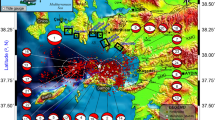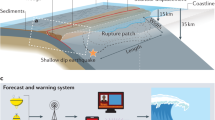Abstract
The coast of California was significantly impacted by two recent teletsunami events, one originating off the coast of Chile on February 27, 2010 and the other off Japan on March 11, 2011. These tsunamis caused extensive inundation and damage along the coast of their respective source regions. For the 2010 tsunami, the NOAA West Coast/Alaska Tsunami Warning Center issued a state-wide Tsunami Advisory based on forecasted tsunami amplitudes ranging from 0.18 to 1.43 m with the highest amplitudes predicted for central and southern California. For the 2011 tsunami, a Tsunami Warning was issued north of Point Conception and a Tsunami Advisory south of that location, with forecasted amplitudes ranging from 0.3 to 2.5 m, the highest expected for Crescent City. Because both teletsunamis arrived during low tide, the potential for significant inundation of dry land was greatly reduced during both events. However, both events created rapid water-level fluctuations and strong currents within harbors and along beaches, causing extensive damage in a number of harbors and challenging emergency managers in coastal jurisdictions. Field personnel were deployed prior to each tsunami to observe and measure physical effects at the coast. Post-event survey teams and questionnaires were used to gather information from both a physical effects and emergency response perspective. During the 2010 tsunami, a maximum tsunami amplitude of 1.2 m was observed at Pismo Beach, and over $3-million worth of damage to boats and docks occurred in nearly a dozen harbors, most significantly in Santa Cruz, Ventura, Mission Bay, and northern Shelter Island in San Diego Bay. During the 2011 tsunami, the maximum amplitude was measured at 2.47 m in Crescent City Harbor with over $50-million in damage to two dozen harbors. Those most significantly affected were Crescent City, Noyo River, Santa Cruz, Moss Landing, and southern Shelter Island. During both events, people on docks and near the ocean became at risk to injury with one fatality occurring during the 2011 tsunami at the mouth of the Klamath River. Evaluations of maximum forecasted tsunami amplitudes indicate that the average percent error was 38 and 28 % for the 2010 and 2011 events, respectively. Due to these recent events, the California tsunami program is developing products that will help: (1) the maritime community better understand tsunami hazards within their harbors, as well as if and where boats should go offshore to be safe, and (2) emergency managers develop evacuation plans for relatively small “Warning” level events where extensive evacuation is not required. Because tsunami-induced currents were responsible for most of the damage in these two events, modeled current velocity estimates should be incorporated into future forecast products from the warning centers.








Similar content being viewed by others
References
Admire, A.R., Dengler, L.A., Crawford, G.B., Uslu, B.U., Montoya, J., and Wilson, R.I. (2011), Observed and modeled tsunami current velocities on California’s north coast: 2011 Fall Meeting, American Geophysical Union, San Francisco, CA; abstract NH14A-03.
Barberopoulou, A., Borrero, J.C., Uslu, B., Kalligeris, N., Goltz, J.D., Wilson, R.I., and Synolakis, C.E. (2009), Unprecedented coverage of the Californian coast promises improved tsunami response: EOS. Trans American Geophysical Union, 90(16), 137–138.
Barberopoulou, A., Legg, M.R., Uslu, B., and Synolakis, C.E. (2011a), Reassessing the tsunami risk in major ports and harbors of California I: San Diego; Nat. Hazards, 58(1), 479–496.
Barberopoulou, A., Borrero, J.C., Uslu, B., Legg, M.R., and Synolakis, C.E. (2011b), A second generation of tsunami inundation maps for the State of California. Pure and Applied Geophysics, 168(2011), 2133–2146.
California Seismic Safety Commission (2005), The tsunami threat to California: Ad Hoc Committee on Tsunami Safety, CSSC 05-03, 24 pp.
Dengler, L, Uslu, B, Barberopoulou, A., Borrero, J., and Synolakis, C. (2008), The vulnerability of Crescent City, California to tsunamis generated by earthquakes in the Kuril Island region of the northwestern Pacific. Seismological Research Letters, 75(5), 608–619.
Dengler, L., Uslu, B., Barberopoulou, A., Yim, S.C., and Kelly, A. (2009), Tsunami damage in Crescent City, California from the November 15, 2006 Kuril event. Pure and Applied Geophysics, 166(1–2), 37–53.
Dengler, L.A. (2011), Evaluation of tsunamis in California since 1900 (unpublished figure).
Fritz, H.M., Petroff, C.M., Catalan, P.A., Cienfuegos, R., Winckler, P., Kalligeris, N., Weiss, R., Barrientos, S.E., Meneses, G., Valderas-Bermejo, C., Ebeling, C., Papadopoulos, A., Contreras, M., Almar, R., Dominguez, J.C., and Synolakis, C.E. (2011), Field survey of the 27 February 2010 Chile tsunami. Pure and Applied Geophysics. doi:10.1007/s00024-011-0283-5.
Gica, E., Spillane, M.C., Titov, V.V., Chamberlin, C.D., and Newman, J.C. (2008), Development of the forecast propagation database for NOAA’s Short-term Inundation Forecasting for Tsunamis (SIFT): NOAA Technical Memorandum OAR PMEL-139, 89 pp.
Horrillo, J., Knight, W., and Kowalik, Z. (2008), Kuril Islands tsunami of November 2006: 2. Impact at Crescent City by local enhancement. Journal of Geophysical Research, 113, 12 pp.
Kowalik, Z., and Whitmore, P.M. (1991), An investigation of two tsunamis recorded at Adak, Alaska. Science of Tsunami Hazards, 9, 67–83.
Kowalik, Z., Horrillo, J., Knight, W., and Logan, T. (2008), Kuril Islands tsunami of November 2006: 1. Impact at Crescent City by distant scattering. Journal of Geophysical Research, 113, 11 pp.
Lander, J., Lockridge, P.A., and Kozuch, J. (1993), Tsunamis affecting the west coast of the United States 1806-1992: NGDC Key to Geophysical Research Documentation No. 29, USDOC/NOAA/NESDIS/NGDC, Boulder, CO, USA, 242 pp.
Lynett, P., Borrero, J, Weiss, R., Son, S., Greer, D., and Renteria, W. (2012), Observations and Modeling of Tsunami-Induced Currents in Ports and Harbors. Earth and Planetary Science Letters, 327/328, 68–74.
Mesiti-Miller Engineering, Inc. (2011), Tsunami damage evaluation of all fixed and floating facilities at the Santa Cruz Small Craft Harbor: consulting report for the Santa Cruz Port District dated June 6, 2011, MME #11118, with appendices, 13 pp.
National Police Agency of Japan (2012), Damage Situation and Police Countermeasures associated with 2011 Tohoku district—off the Pacific Ocean Earthquake March 5, 2012. http://www.npa.go.jp/archive/keibi/biki/higaijokyo_e.pdf.
NGDC (2012), National Geophysical Data Center Historic Tsunami Data Base at: http://www.ngdc.noaa.gov/seg/hazard/tsu_db.shtml.
Northern California Tsunami Unified Command (2011), Joint press release for March 16, 2011: comprised of U.S. Coast Guard; NOAA; California Department of Fish and Game, Office of Spill Prevention and Response; California Department of Boating and Waterways, 4 pp.
Rabinovich, A.B., Stephenson, F.E., and Thomson, R.E. (2006), The California tsunami of 15 June 2005 along the coast of North America: Canadian Meteorological and Oceanographic Society. Atomosphere-Ocean, 44(4), 415–427.
SEEDS Asia (2011), The Great Eastern Japan Earthquake, In depth damage report by affected cities, April 28. http://www.seedsasia.org/eng/projectsjapan.html.
Tohoku Earthquake Tsunami Joint Survey Group (2011), Nationwide field survey of the 2011 off the Pacific Coast of Tohoku earthquake tsunami. Journal of Japan Society of Civil Engineers, Sr. B2 (Coastal Engineering), 67(1), 63–66.
Uslu, B., Eble, M., Titov, V.V., and Bernard, E.N. (2010), Distant tsunami threats to the ports of Los Angeles and Long Beach, California: NOAA OAR Special Report, Tsunami Hazard Assessment Special Series, 2, 100 pp.
Weston Solutions Inc. (2011), Results of chemical, physical and biological testing of sediments from Crescent City Harbor: consulting report dated August 17, 2011, 49 pp.
Whitmore, P.M., Benz, H., Bolton, M., Crawford, G., Dengler, L., Fryer, G., Goltz, J., Hanson, R., Kryzanowski, K., Malone, S., Oppenheimer, D., Petty, E., Rogers, G., and Wilson, J. (2008), NOAA/West Coast and Alaska Tsunami Warning Center Pacific Ocean Response Criteria, Science of Tsunami Hazards, 27, 1–21.
Wilson, R.I., Barberopoulou, A., Miller, K.M., Goltz, J.D., and Synolakis, C.E. (2008), New maximum tsunami inundation maps for use by local emergency planners in the State of California, USA: EOS Trans. American Geophysical Union 89(53), Fall Meeting Supplement, Abstract OS43D–1343.
Wilson, R.I., Dengler, L.A., Legg, M.R, Long, K., and Miller, K.M. (2010), The 2010 Chilean Tsunami on the California Coastline. Seismological Research Letters, 81(3), 545–546.
Wilson, R.I., Dengler, L.A., Goltz, J.D., Legg, M.R., Miller, K.M., Ritchie, A., and Whitmore, P.M. (2011a), Emergency response and field observation activities of geoscientists in California (USA) during the September 29, 2009, Samoa tsunami. Earth-Science Reviews, 107(2011), 193–200.
Wilson, R., Dengler, L., Borrero, J., Synolakis, C., Jaffe, B., Barberopoulou, A., Ewing, L., Legg, M., Ritchie, A., Lynett, P., Admire, A., McCrink, T., Falls, J., Rosinski, A., Treiman, J., Manson, M., Silva, M., Davenport, C., Lancaster, J., Olson, B., Pridmore, C., Real, C., Miller, K., and Goltz, J. (2011b), The effects of the 2011 Tohoku tsunami on the California coastline: [abstract] Seismological Research Letters, 82(3), 459–460.
Wilson, R., Davenport, C., and Jaffe, B. (2012-in press), Sediment scour and deposition within harbors in California (USA), caused by the March 11, 2011 Tohoku-oki Tsunami. Sedimentary Geology. doi:10.1016/j.sedgeo.2012.06.001
Acknowledgments
The authors would like to thank NOAA, the National Tsunami Hazard Mitigation Program, and FEMA for supporting tsunami hazard mitigation and response activities in California. Thank you to the California Geological Survey, NOAA-National Weather Service Warning Coordination Meteorologists in California, the California Harbor Master and Port Captain Association, the California Coastal Commission, and the state and county emergency managers who are part of the California Tsunami Program Steering Committee for their participation in the post-event questionnaires and surveys.
Author information
Authors and Affiliations
Corresponding author
Rights and permissions
About this article
Cite this article
Wilson, R.I., Admire, A.R., Borrero, J.C. et al. Observations and Impacts from the 2010 Chilean and 2011 Japanese Tsunamis in California (USA). Pure Appl. Geophys. 170, 1127–1147 (2013). https://doi.org/10.1007/s00024-012-0527-z
Received:
Revised:
Accepted:
Published:
Issue Date:
DOI: https://doi.org/10.1007/s00024-012-0527-z




